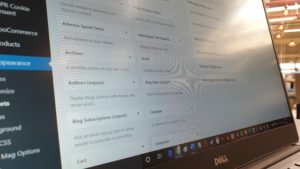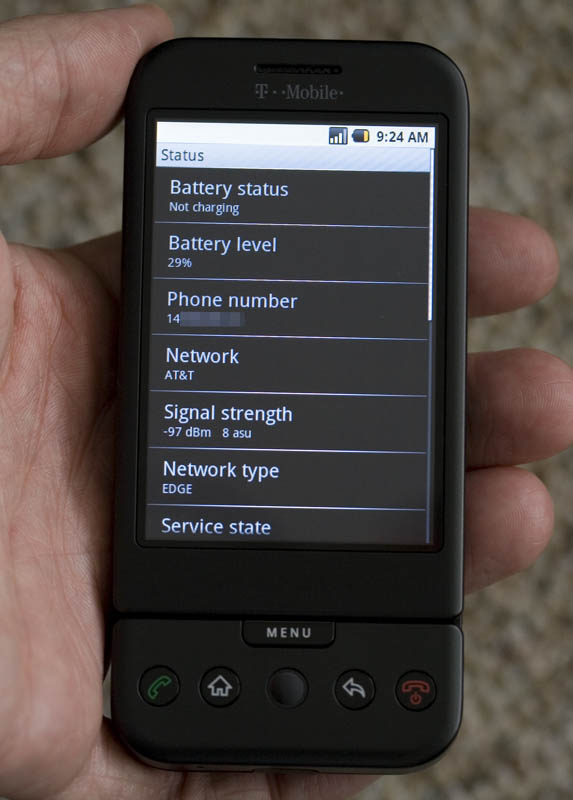Affiliate links on Android Authority may earn us a commission. Learn more.
How to become a blogger - Your complete guide
Published onNovember 14, 2019

If you want to know how to become a blogger, you need to know a lot more than simply how to “build” a blog. Success comes down to a huge amount of hard work, smart planning and branding, consistency, and of course a bit of luck.
But it’s worth learning how to become a blogger despite the challenge. This is a very strong contender for “best job in the world!”
As a blogger, you’ll be spending your time writing articles (posts) about things that you find interesting. There will be very little time pressure, and you’ll largely be able to decide the topic of each new thing you write. A successful blogger will also be able to enjoy enthusiastic feedback from countless readers, and active discussion around subjects that make them come alive.

On top of all this, a blogger will earn a passive income. That means they’ll be earning money even when they aren’t working – even while they sleep.
Also read: 7 easy passive income ideas to make money while you sleep
A successful blog can also act as a stepping stone to countless other opportunities: whether that means getting to write a book, or appearing in other media.
So how do you become a blogger? Let’s find out.
How to create a blog
The first step to becoming a blogger is to create a blog! This is something that I’ve discussed in a previous Android Authority post. To very briefly recap, this should be a WordPress website. That means that it will be built using the web’s most popular content management system (CMS). WordPress powers over a quarter of all sites on the net, is completely free and open source, and comes with a huge, active community of developers and users.
WordPress powers over a quarter of all sites on the net!
While you could build your own website from scratch, or using another tool, using WordPress will give you all the freedom and flexibility you need in a widely supported format. As some of the most successful sites in the world are powered by WordPress, you’ll never worry that your site isn’t ranking on Google because of the way you coded it, for example.
Read more: How to build a WordPress website for a business or side hustle
Creating a brand for your blog
Before you can start designing your blog, you’re also going to need a subject matter, a website name, and a logo. In other words: you need a brand!
If you want to know how to become a blogger, then creating a strong brand is one of the most crucial steps.
Creating a strong brand is one of the most crucial steps.
In terms of the topic (referred to as a “niche” in the industry), the most important thing by far is that you choose a subject you’ll be happy writing about for years to come. Growing a successful site takes a lot of time, and if you don’t love what you’re doing, chances are you’re going to give up before you really make a splash.
Likewise, writing about a topic you know will ultimately yield far better quality content. If you are writing about fitness but you’ve never set foot in the gym, at best you’re going write content that has been rehashed from elsewhere. That means it will be generic and derivative. True success comes from being a “thought leader.” And that rather means you need to come up with something new!
Writing about a topic you know will ultimately yield far better quality content.
That said, there are some strategic pointers to keep in mind when choosing your niche. Mainly: don’t be too broad. “Fitness” is far too broad a topic, so hone in on one particular niche within that broader category. For example: you might write about fitness for people over 50. Maybe you want to write about the paleo lifestyle. Maybe you like CrossFit.

Alternatively, you could appeal to a more specific audience by combining multiple different areas of interest. A great example is Nerd Fitness which combines fitness and superhero pop culture. Another example is a site like Art of Manliness, which effectively created a new niche by taking the vague concept of masculinity and defining it. My own site, The Bioneer, combines fitness with brain training and other forms of performance/self-development. This doesn’t appeal to everyone, but lots of people tell me how they’ve been searching for “something like this” for ages. My site is just right for those people.
The bottom line is that if you go too broad, you’ll be unfocused and the competition will be immense. Instead, think about what makes you unique and different and double-down on that. Try to appeal to everyone, and you’ll ultimately appeal to no one.
Try to appeal to everyone, and you'll ultimately appeal to no one.
Think about your “buyer persona” and your perfect reader, think about who that person is, and what they like. Make your site for them. Come up with a “mission statement” that explains what your business is all about, and what you hope to achieve through it. Then make sure everything you do is in service of that mission.
The name of your site and the URL you choose should both be representative of this niche and mission. Of course, it should also be memorable and unique. You might want to trademark this name later on too, so it’s worth doing a search to make sure it’s not already taken. We’ll talk about that in future.
This is how to start a successful blog with genuine fans, as opposed to a site that people click away from as soon as it loads.
Website Design and Logo
Next you need a logo, and you need a design for your blog.
When designing a logo, you need to acquire a vector file (not raster), meaning that it will be drawn via a series of instructions rather than a map of pixels. This means you can grow and shrink the image with no loss of quality, and that you can easily edit the image as needed. This allows you to create different versions of your logo while keeping all the proportions and colors the exact same. A JPEG is just not able to do that.
Also read: How to become a digital artist
A good logo should also be relatively simple and memorable, and it should be easy to replicate and use in different ways. How your logo would look as an advert on another website? Printed onto packaging? How would it look as a plain silhouette?
Most importantly though: your logo should perfectly express your mission statement and niche, and it should appeal to the target demographic. Again, the aim is not to appeal to everyone. Instead, someone looking at your logo should instantly get a feel for what your business is all about, the emotions you’re trying to create, and whether or not they are likely to enjoy your content.

This is a crucial step on your journey to become a blogger, as it will be what ultimately sets the tone for your content, and encourages the right people to stick around long enough to read what you have to say.
If you have trouble coming up with a unique name or logo for your website, you can try using a mood board. Here, you’ll create a collage of words and images that all speak to you and reflect the topic of the site. Take shots of other sites you like, of book covers, or even of color schemes. Likewise, write down words that describe the niche of your business, and any synonyms you think of.
You can then try combining those images and words in different unique ways to find unique imagery and styles.
Of course, if you struggle with logo design, then you can always outsource this using a website such as 99Designs.com. Much of learning how to become a blogger involves knowing when to defer to someone more talented!
Designing the actual site will mainly involve installing and customizing a WordPress theme. When you do this, try to use the logo you’ve settled on to inform your design choices. The colors of the logo should be reflected in the site. Spend some time reading about color theory and fonts, and make sure your site uses a responsive mobile design (meaning it will look great on mobile devices and large ultrawide monitors alike).
Also read: How to build accelerated mobile pages (and what it means)
Ultimately, your blog needs to be professional enough that it can compete with the very best in your niche – while also being completely unique to you.
How to become a blogger – start writing!
Once you have your site design up and running, the next step is of course to start writing blog posts!

This is going to be your bread and butter, and it is what will ultimately ensure the success of your site.
The most important tip? Make sure you have something new to say. Make sure that your article headlines grab the attention of people interested in your niche. Do this by discussing topics and angles they may not have encountered before, or by creating some kind of emotional response.
Google now prefers long-form content.
Think about the “value proposition” offered by each post. How will reading this make their lives better? Don’t just rehash what other people have said before!
Likewise, make sure to make your articles long enough to provide real value. Google now prefers long-form content (800 words+), though of course you should let the content dictate the word count. How many words does it need?
Learning to improve your writing style and minimizing errors is also important of course, but this is something you will develop with time.
Also read: How to find work online as a freelance copywriter
The most important thing of all is to be consistent: and this is where most people fall down when they want to learn how to become a blogger. Aim to write a few posts every week and to post them without failure. If you go weeks on end with no new updates, then you’ll lose whatever momentum you have.
Keep writing away, and do it for the love of writing.
This can be hard. Especially when at first no one seems to be looking at your content! You’ll maybe get 10 views for each new post when you first start out, despite having spent hours writing them and sourcing attractive images.
Keep in mind though that this content isn’t “wasted.” You will be able to re-promote it later on, in order to help it gain more traction.
Just keep writing away, and do it for the love of writing.
Marketing and growth hacks for your blog
Now you know how to become a blogger, but you’ve yet to figure out how to make that blog a success!
This is where marketing and growth hacks come in. To market your new blog, you will likely use a combination of social media and search engine optimization (SEO). The latter involves the use of keywords (things people search for on Google) which you will subtly include in your content. You also need to think about getting other sites to link to you, which helps Google to find your content and makes it appear popular (and therefore worth promoting).
Promoting yourself on social media is a matter of creating social accounts for your new brand (on Instagram, Facebook, and Twitter at least) and then sharing your new content there. You can also use these networks to build more engagement.
For example, if you have a food blog, then you can use an Instagram account with stunning photos of food and recipes to help more people discover your brand. You can then promote the blog from said Instagram account.
It’s also a good idea to integrate social media into your website design itself. WordPress lets you add advanced features by installing plugins, and this way you can – for example – display a feed from your social accounts in the sidebar, or allow visitors to share your posts to their social networks.

If you keep writing great content and take these basic steps to promote yourself, then your site and your notoriety will grow gradually over time.
(I also highly recommend creating a YouTube channel to promote your blog, though I realize not everyone feels comfortable with this option.)
This can be a slow process though, which is where “growth hacks” come in.
How to become a blogger with growth hacks
Growth hacks are methods you can use to rapidly increase the visibility of your blog. Here are a few examples:
Guest Posting: This involves writing a blog post or article for another website in your niche and then letting them publish it for free. The deal is that they will let you include a link back to your own site. This is great from an SEO perspective as Google likes to see other big sites linking to you, but it also acts as a way to get that site’s readers to visit your blog directly. This is almost like a testimonial.
This is another reason your web design needs to be exceptional: otherwise serious blogs won’t want to associate with you!
Influencer Marketing: Influencer marketing is similar to guest posting, except here you are asking for a “shoutout” from an influencer. This is someone on Instagram or YouTube, or another blogger, who will tell their followers about you and recommend your site. This essentially allows you to benefit from their huge audience and the trust they have built with that audience. In exchange, you might provide them with a similar shout-out, or you might just pay for the privilege. You could even offer to work with them on a joint project or post of some sort. If you’re very lucky, some influencers will do this for free!

The problem with both these strategies is getting the blog/influencer to answer you. The best advice I can give here is to work your way up. Don’t go after the biggest names in your niche on day one, but instead approach someone who is roughly at your level initially, and then go after bigger fish as you gain momentum. Look for people who stand to benefit from the arrangement as well.
Link Baiting: Link baiting means creating content that is extremely useful (such as a comprehensive resource), that perfectly argues a certain point, or that is highly controversial. The aim is to get people to link back to your site and to reference what you’ve written. This is easier said than done, of course.
Media Coverage: Finally, if you can get your blog covered by bigger media, this can result in huge exposure. Some bloggers will accomplish this by taking on personal challenges, or by pulling a publicity stunt. You can then submit press releases to websites and direct to journalists. Just remember that in order for a press release to be picked up, a journalist needs to think that your story is of interest to their readers; it can’t just amount to free promotion for your blog!
Note: There are more growth hacks out there. But if you want more content on how to become a blogger, then let me know in the comments and I’ll make it into a feature!
Whatever methods you use to grow your blog, it takes a long time to become a blogger full time.
Keep in mind that whatever methods you use to grow your blog, it takes a long time to become a blogger full time. Don’t aim for this then! Instead, aim to write a blog in your free time, to earn a little bit of money on the side, and to only try going full time once your blog has gained the traction it needs.
Don’t set out to get rich. Set out to earn a little side income from a passion project.
Monetization for bloggers
If you want to know how to become a professional blogger, then you need to know how to start earning money from your site. There are a few ways to do this.
The most popular for many new bloggers is something called AdSense. AdSense is an advertising platform from Google that pays for every click (this is called PPC). You sign up, then add snippets of code around each page. These slots will then show adverts that advertisers bid for, and every time one gets clicked, you’ll earn somewhere between $0.01 and $2.00. On average, you should expect about $0.10 for each click.
Unfortunately, it’s also common for click-through rates (CTRs) to be very low. When was the last time you clicked on an advert on a website? Getting one or two clicks for every thousand visitors is not uncommon, meaning that it can take a long time before this method allows you to earn any serious money. This is not how to become a blogger full time.

Better then is to try and sell something from your blog. A popular option is to sell an affiliate product, which will earn you commission on sales. You can become an Amazon affiliate (called an Amazon Associate) and that way, you might earn as much as 8% on each sale.
Alternatively, you could sell a digital product through a site like JVZoo or Clickbank. These sites offer much higher commissions – up to 90% in some cases! Of course though, you’ll be limited to selling ebooks written by other people, which can be a bit of a hard sell.
The better option then is to sell your own digital product, such as an ebook.
This way you can keep 100% of the profit and you’ll be able to create a product that perfectly fits the brand of your site and targets your audience. If people love what you’re writing and they see your digital product as an extension of that content, then this can be much easier to convince people to buy.
Another great option is to sell a service. Whether you’re a life coach, a business consultant, a web designer or anything else, you can use a blog to establish authority and trust, and to reach a wide audience that you can sell to.
The secret to real success
I just want to take a moment to really re-emphasize why a strong brand and excellent content are so important for anyone looking to become a blogger.
In my freelance writing gig, I work with hundreds of clients who are all looking to be successful online. They hire me to write content for their sites, but unfortunately, they are doomed from the start.

That’s because their entire approach is wrong. It is a cynical attempt to earn money from visitors, while investing the minimal amount of time and money into the process. They design a generic website in a niche that they think can make them a lot of money – let’s say they want to sell running shoes through affiliate links so they create a site called “BuyRunningShoes.com”.
Then they hire me to write their content. Already this is a mistake, as they have no idea whether I actually know anything about running shoes or not (as it happens – and luckily for them – I do!). Even the best writer in the world won’t produce game-changing content unless they are truly passionate about the topic and an expert in that field.
Most likely, they’ll end up with articles like “Top 5 Running Shoes” which will simply be pulled from other similar articles online, and might include one or two shoes that are actually last years’ models.
The site name is not a brand – it’s a keyword. And every article exists purely to try and sell something. There is no broader narrative, no target demographic, and no mission statement other than “sell shoes.”
Worse are the sites that try to cram keywords.
Readers can tell the difference instantly and so they leave as quickly as they arrive. People who know about shoes will see that the site is amateur hour, and people who don’t aren’t being given any compelling reason to stick around.
Worse are the sites that try to “cram” keywords (so that every other word becomes the search term), or that write positive reviews of products they’ve never even tried.
Only passion and commitment will be enough.
Think about the biggest and most popular sites on the web. Think about the blogs that you actually read. These are not sites that were designed cynically by someone with no interest in the topic.
These are professionally designed sites, written by people with a lot of passion, and a unique perspective.
If you want to know how to become a blogger – it’s by taking a cue from those sites. This is not something you can rush, and only passion and commitment will be enough to get you to that point.